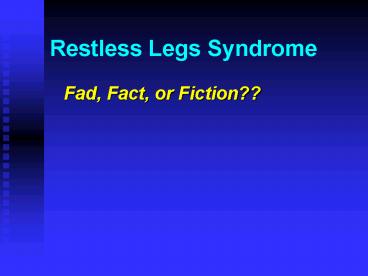Restless Legs Syndrome PowerPoint PPT Presentation
1 / 33
Title: Restless Legs Syndrome
1
Restless Legs Syndrome
- Fad, Fact, or Fiction??
2
RLS Definition
- A disorder characterized by an almost
irresistible urge to move, usually associated
with disagreeable leg sensations, worse during
inactivity, often interfering with sleep.
3
Primary Features(IRLSSG Criteria)
- Desire to move the limbs, usually associated with
paresthesias/dysesthesias - Motor restlessness
- Symptoms worse at rest, partially relieved by
activity - Symptoms worse in the evening or at night
4
Uncomfortable Sensations
- Creepy, crawly, tingly
- Like worms or bugs crawling under the skin
- Painful, burning, or achy
- Like water running over the skin
- Sometimes indescribable
5
Restlessness
- Voluntary-patients choose to move to relieve
discomfort - Involuntary-patients feel compelled to move and
almost cannot resist it (as a tic)
6
Rest and Activity
- Activity variably, temporarily, and partially
relieves the discomfort - Patients develop habits and behaviors to relieve
discomfort (Nightwalkers)
7
Circadian Variability
- Symptoms typically peak between midnight and 4
Am.. - Circadian rhythm of symptoms persists even in
unconventional sleep /wake cycles
8
Additional Features
- Sleep disturbance and its consequences
- Involuntary movements while awake
- Generally chronic course
9
RLS Vs PLMS
- RLS is a symptom
- RLS is diagnosed in the physicians office
- 80 of people who have RLS will have PLMs
- PLMs are an electromyographic finding
- PLMs are diagnosed in the sleep laboratory
- 30 of individuals who have PLMs have RLS
symptoms
10
Clinical Importance of PLMs in Relation to RLS
- PLMs are neither necessary nor sufficient to
make the diagnosis of RLS - Asymptomatic PLMs do not require treatment
11
Pathogenesis of RLS
- Primary or idiopathic
- Secondary
12
Primary RLS
- No identifiable predisposing factor
- Tends to occur in families
- May be genetic
13
Secondary RLS
- Iron-deficiency anemia
- Uremia (20-40 of dialysis patients)
- Pregnancy (up to 27)
- Neurological lesions
- both spinal cord and peripheral nerve lesions
- Drug-induced
- tricyclics, SSRIs, lithium, dopamine
- blockers (e.g., neuroleptics), xanthines
14
Associated Conditions
- Diabetes
- Parkinsons disease
- Rheumatoid arthritis
15
Differential Diagnosis
- Neuropathy
- Lumbar disk disease/spinal stenosis
- Depression and other causes of insomnia
- Arthritis
- Vascular disease
- Akesthesia
16
Pathogenesis
- RLS is a neurologic movement disorder
- Location of the lesion is not known
- Some evidence points to spinal cord abnormalities
in patients with PLMs
17
Consequences of RLS
- Discomfort
- Sleep disturbance
- Excessive daytime somnolence
18
Assessment-Making the Dx
- History
- Physical examination
- Laboratory tests
19
History 4 Cardinal Features
- Unpleasant sensations
- Motor restlessness
- Precipitated by inactivity Relieved with
activity - Worse in evening or night
20
Historical Assessment in RLS
- Diabetes, anemia, medications, renal status and
other associated conditions - Duration of symptoms
- Other affected family members
- Precipitating and relieving factors (new
medications, lifestyle changes)
21
Physical Examination in RLS
- Careful neurological examination (to look for
Parkinson's, neuropathy, weakness) - No objective findings for RLS
22
Laboratory Evaluation of RLS
- Polysomnography is not indicated in evaluation of
RLS! - Serum ferritin
- Screen for uremia
- Screening for diabetes
- Other tests for potential secondary causes if
suspected
23
Nonpharmacologic Treatment
- Listen, support, and validate
- Reconsider medications known to exacerbate RLS
(Lithium, SSRIs, tricyclics, dopamine
antagonists) - Not helpful sclerotherapy, electrical
stimulation - Possibly beneficial in some patients hot baths,
delayed sleep time/rise time, exercise, avoid
alcohol and nicotine
24
Support and Validation
- Sleep Thief, by Virginia Wilson. Galaxy Books,
1996. - Restless Legs Syndrome Foundation (RLSF)
www.RLS.org
25
Pharmacologic Treatment
- Dopaminergic medications
- Benzodiazepines
- Opioids
- Anticonvulsants
- Others
26
Treatment Considerations
- Age of patient
- Combination strategies
- Distribution/frequency/severity of symptoms
- No drug has FDA approval for use in RLS
(off-label use) - Treatment is symptomatic, not curative
- In general, smaller doses are used than in other
conditions
27
Iron Therapy
- Replace iron in patients with serum ferritin
levels below 50 mcg/L
28
Dopaminergic Medications
- carbidopa-levodopa (Sinemet Ò)
- 25-100 CR-100/400 CR qhs
- bromocriptine (Parlodel Ò)
- 5-15 mg
- pergolide (Permax Ò)
- 0.05 qhs, increasing by 0.05 q 3 days
- pramipexole (Mirapex Ò)
- 0.125-1.0 mg qhs
Disadvantages augmentation, rebound, nausea,
insomnia
29
Benzodiazepines
- clonazepam (Klonipin Ò)
- 0.5-4.0
- lorazepam ( Ativan Ò)
- temazepam (RestorilÒ)
- 15-30 mg
- diazepam (Valium Ò)
- 5-10 mg
Disadvantages tolerance, somnolence, confusion,
worsened snoring/SDB
30
Opioids
- propoxyphene (Darvon Ò)
- 130-520 mg/day
- codeine
- 15-240 mg/day
- methadone (Dolophine Ò)
- 5-30 mg/day
- hydrocodone
- tramadol hydrochloride (Ultram Ò)
Disadvantages tolerance, constipation
31
Anticonvulsants
- gabapentin (Neurontin Ò)
- 100-2700mg/day
- carbamazepine (Tegretol Ò)
Disadvantages daytime sedation
32
Others
- clonidine
- baclofen
- vitamin B 12
- vitamin E
- magnesium
33
Conclusions
- RLS is common, treatable, and underdiagnosed
- The pathophysiology of RLS is unknown
- RLS can be both secondary and idiopathic
- The diagnosis is made by history
- Treatment is mainly pharmacologic

